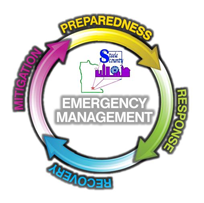Example Differences Between RACES and ARES Operations
| Activation | Except for drills, starts as a result of an emergency, active during the emergency, and deactivated shortly after the emergency has cleared. | Operations can take place in advance of an emergency, during the emergency, and an indefinite time after the emergency has cleared. |
| Operator Registration |
Must be registered with the local emergency management agency. | Does not have to be registered. Suggested to register with local ARES Emergency Coordinator. |
| Communications | Restricted to/from other RACES stations. | Limited only by standard Amateur Radio rules. |
| Messages | Communications must be specifically authorized by the civil defense organization for the area served. Generally limited to public safety, immediate safety of life of individuals, the immediate protection of property, maintenance of law and order, alleviation of human suffering and need. | Limited only by standard Amateur Radio rules. Example: Health and Welfare would be allowed in ARES, but may not be allowed in RACES. |
| Drills | Cannot exceed a total time of one hour per week. With proper authorization, drills may be conducted twice in a calendar year for a period not to exceed 72 hours. | Limited only by standard Amateur Radio rules. |
| Served Agencies |
Limited to emergency management organizations. | Emergency management organizations as well as other non-profit organizations. |
| Restricted Operations |
May be allowed to operate in a communication emergency when other amateur radio stations are restricted from doing so. | May be restricted from operating in some communication emergencies. |
Updated 09-Sep-2019
